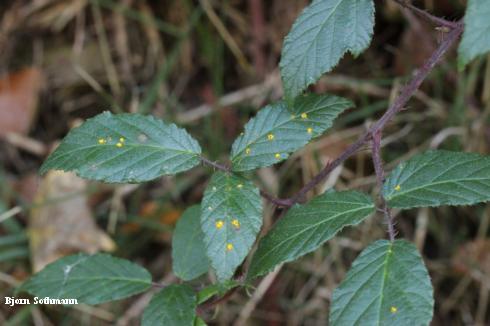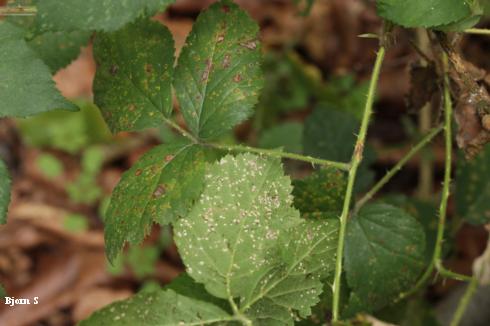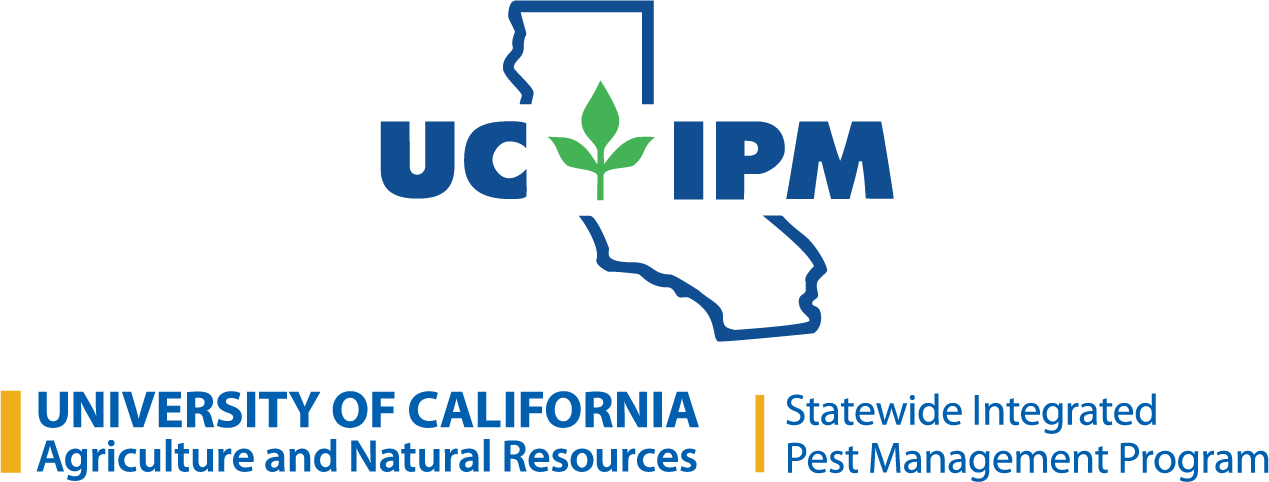The cane and leaf rust fungus affects some blackberry cultivars, especially trailing varieties such as olallieberry, and can reduce fruit yield.
Identification
The first symptom of cane and leaf rust is yellow to orange pustules (uredinia) that erupt from the bark of the fruiting canes of susceptible blackberries. During wet weather in early summer, spores (urediniospores) from these pustules infect leaves and produce small, yellow uredinia on the leaves. Brownish yellow fruiting bodies (telia) develop among the uredinia on leaves in early fall. The telia produce teliospores that can infect the primocanes (vegetative canes, those that don't produce fruit). Infected primocanes can develop orangish pustules, called aecia and spermagonia. Orangish pustules (photograph by Oregon State University) may also develop on fruit.

Licensed under a Creative Commons Attribution-ShareAlike 4.0 International License
It is important not to confuse the relatively common cane and leaf rust with the less common but more damaging orange rust. Orange rust causes infected plants to produce many small, weak shoots from the base of the plant. Cane and leaf rust can be distinguished by the presence of yellow pustules (uredinia) on both the canes and leaves. Orange rust causes orange pustules only on the leaves.
Caneberries can also be infected with late leaf rust and yellow rust and these diseases can result in signs and symptoms resembling those of cane and leaf rust and orange rust. The season of rust appearance and which caneberry plant parts and varieties are affected helps to distinguish the pathogens causing these diseases. However, expert examination of spores may be required to confidently distinguish which fungal pathogen is causing the rust.

Licensed under a Creative Commons Attribution-ShareAlike 2.0 Generic License
Life Cycle
The fungus overwinters on canes as mycelia, uredinia, or both. Elongate, yellow uredinia form on infected floricanes (canes that produce fruit) in late spring. Wet spring weather and overhead irrigation favor pathogen infection and disease development in new growth.
Damage
On susceptible blackberry varieties, leaf defoliation from cane and leaf rust can be severe and result in significant loss of plant vigor. Infected floricanes and primocanes canes become brittle and may break. Premature defoliation can occur if infection is severe. This can weaken plants and reduce fruit yield. Normally cane and leaf rust does not infect the fruit, but fruit can become infected and unpalatable.
Solutions
Grow raspberries where they will receive full sun. Plant them on a raised berm or mound of soil to improve air circulation around the plants. To keep plants drier use drip irrigation instead of sprinklers. Control weeds to improve air circulation and reduce humidity around plants. Remove any wild caneberries near those grown for fruit because wild caneberries can be alternate hosts from which the pathogen can spread.
Any method of pruning and trellising that improves air circulation around caneberries helps to reduce late leaf rust because this allows flowers, fruit, and leaves to dry more quickly. The dry conditions in a macrotunnel (hoop house covered with clear plastic) greatly limit rust development. Remove and dispose of fruiting canes soon after harvest to reduce sources of overwintering pathogen inoculum.
Where the fungus has been a problem, spray caneberries with Bordeaux mixture or another copper fungicide in fall after pruning off and disposing of the fruiting canes. Bordeaux mixture or another copper fungicide can be applied during the delayed dormant season, when buds swell but before they open. Additionally if rust disease has previously been severe, a fixed copper or myclobutanil can be sprayed during the first bloom.
References
Adapted from Blackberry (Rubus spp.)-Cane and Leaf Rust, Pacific Northwest Plant Disease Management Handbook and Pest Management Guidelines: Caneberries, University of California Statewide Integrated Pest Management Program (UC IPM).
